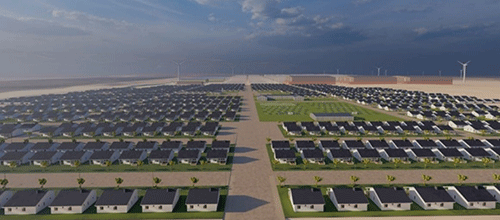The juggernaut that Namibia’s green hydrogen industry is expected to become moved one step closer to fruition after one of the four successful applicants for pilot projects, the Daures Green Hydrogen Village (DGHV), was launched in Windhoek on Friday.
The project size is 1.5 GW (current phase 508 kg green ammonia/day) in the Erongo region’s Dâures constituency, with a capital investment value of 15.1 million euros (about N$280 million at current exchange rates).
The project is expected to realise the production of green hydrogen and ammonia as well as the utilisation of its derivatives.
This is further expected to lead to the sustainable production of green hydrogen, based on renewable energies as well as the establishment of a green scheme programme for ammonia nitrate crops, and the storage and transport of green hydrogen, ammonia and related derivatives.
The project will further integrate application technologies for the utilisation of green hydrogen in agriculture, ammonia nitrate and cleaning detergents as well as fuel cell-operated centre pivots, boreholes and houses.
Speaking at the launch, DGHV CEO Jerome Namaseb said DGHV will be Africa’s first net zero village.
He explained that during the first phase, the village will employ over 100 Namibians for construction and over 50 permanent Namibians in a modern carbon-free estate.
“The DGHV intends to achieve sustainable production of green hydrogen and ammonia from renewable sources, demonstration of green hydrogen applications and enablement of a green hydrogen economy with the ability to export green hydrogen and ammonia to potential off-takers.
“This will include the sustainable production of net zero green agricultural produce from greenhouses that create local employment and partnership with research opportunities for local and international students,” Namaseb noted.
Daures is the largest constituency in Namibia, with a population of approximately 11 350 people.
Touching on the project phasing, Namaseb stated the pilot phase one is slated for 2022/23, while phase two is scheduled for 2023/24. Phase three is slated for 2026/28, and the final fourth phase is for 2029/32.
“The water supply for the project in the first phase will be sourced from commercial boreholes. Desalinated water for the subsequent phases will be piped to the project site to meet the hydrogen, ammonia, housing and agricultural water requirements. The evacuation of hydrogen for phases 2 to 4 will be through a dedicated hydrogen gas pipeline to the port of Walvis Bay. The project in its 3rd and 4th phases aims to trade liquid ammonia within the region through various ports and eventually export clean ammonia to support Europe’s decarbonisation ambitions,” explained Namaseb.
At the same occasion, green hydrogen commissioner James Mnyupe made it clear the green hydrogen dream is a team effort, as both the public and private sectors are working together to achieve a productive outcome.
“If we get that right, this project will export Namibian-made molecules to other African States to start reducing the carbon content of African agriculture. We are going to start trading in goods that don’t look like meat and fish, and we’re going to start selling electrons and molecules to one another’s tariff-free markets,” stated Mnyupe.
He said Namibia will overcome those who are trying to misguide and distract the country from its true inherent potential: “If we work together, Namibia, believe me, we are world-class. I see it everywhere I travel. So, start believing in yourself and start working with one another,” the hydrogen commissioner advised.
Delivering the keynote address, Chief Zacharias Seibeb from the Dâures Daman Traditional Authority said his community is pleased with the development that is expected to uplift his community’s living standards through the created employment and local investment.
“We are excited to be part of it. The vision, as the plan describes, is to get Namibia to be filled with opportunities and the ability to create sustainable jobs and growth in the economy. Now with this project, we hope we are going to get much-needed development in our infrastructures,” said the chief.
Photo: Daures


